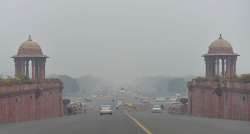'Severe' Delhi air emergency may dissipate over weekend
The toxic haze covering Delhi's skies is that for three weeks stagnant conditions caused by delayed withdrawal of the monsoon had caused a deterioration due to accumulation of pollutants.

The severe air pollution causing health emergency in Delhi that has grabbed international headlines, may dissipate by Saturday-Sunday as favourable weather conditions is forecast that may cause a slow recovery in its air quality index (AQI). The toxic haze covering Delhi's skies is that for three weeks stagnant conditions caused by delayed withdrawal of the monsoon had caused a deterioration due to accumulation of pollutants.
This impact is ending now, according to Safar India (System of Air Quality and Weather Forecasting And Research), under the Ministry of Earth Sciences and Indian Institute of Tropical Meteorology, Pune.
While AQI in Delhi is in the severe plus category, the highest grade of computation at 435, the US Embassy is denoting a sharp improvement in PM 2.5 levels compared to the peak values on Friday of 454.
On Saturday, the PM 2.5 count at 9 a.m. has halved at 208, according to US Embassy data.
According to the forecast by Safar India, the overall air quality of Delhi continues to be in the severe plus. However, as the winds have become westerly from Saturday the further intrusion will be less and slow recovery is expected.
"The AQI is expected to remain in severe category today morning but likely to be recovering further by evening towards upper end of very poor," it said.
A fresh Western Disturbance is likely to advance to eastern regions of northwest India on Saturday, which is likely to positively influence Delhi's air quality by increasing surface and boundary layer winds speed and thereby flushing out the accumulated pollutants.
"SAFAR extended outlook has warned 3 weeks back about the chance of high deterioration in AQI of Delhi during last week of Oct to first week of November for prolonged periods mainly due to delayed withdrawal of monsoon forcing stagnant conditions beneath to arrest any external intrusion for longer period. This impact appears to be ending now, it said.
The worrisome part is that biomass burning in Punjab and Haryana hit a new peak with a contribution of 44 per cent in air pollution but that is expected to dissipate.
The effective stubble fire counts of North west India (Haryana & Punjab) touched a new peak value of this year (3,178) Friday.
The accumulation of pollutants sharply increased and stubble share in Delhi's PM2.5 touched season's high of 44 per cent on October 31 as against the expected 25 per cent. The share is predicted to drop down to 18 per cent by Saturady owing to increase in ventilation index dispersing it.
"By November 3 significant improvement to the very poor is expected," the forecast said.
ALSO READ | Delhi schools shut till November 5
ALSO READ | Delhi's air quality continues to deteriorate, AQI crosses 500-mark